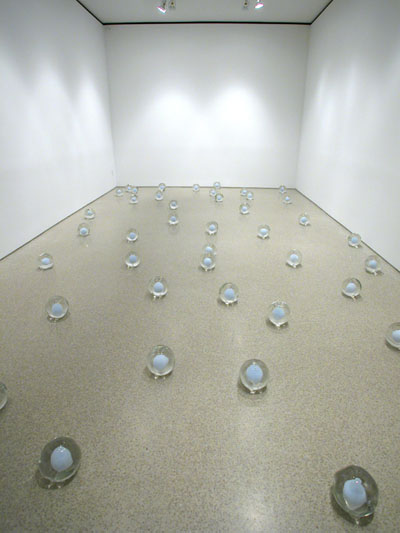 50 Snowballs, 2001 Murano glass, variable sizes Not Vital Sperone Westwater is pleased to announce an exhibition of new work by the Swiss artist Not Vital; it is his first one-person exhibition in New York since 1999. The exhibition will include sculptures in white marble, silver, stainless steel, and Murano glass, as well as several drawings. Not Vital's use of traditional materials places him within a classical sculptural tradition, but his translation of these materials into unique forms has long set his work apart from other sculptors who emerged in the 1970s. In "3000 Tears", the artist has carved 3000 teardrops out of a long, thin piece of white marble that rests upon a stainless steel pedestal. Carved from the same white marble is "Sled", which extends in four directions and appears to be encased in ice. And in reference to the artist's native Engadine region in Switzerland is a glass sculpture entitled "50 Snowballs". Each snowball appears to be frozen within a sphere of ice, and the uncanny realism of these sculptural forms is such that one suspects them to be frozen to the touch. Vital's mountainous homeland is an isolated, wintry world and this exhibition reflects the artist's acute sensitivity to the region's raw conditions and culture. Vital is also a peripatetic wanderer, and juxtaposed with works like "50 Snowballs" are a number of pieces inspired by his extensive time spent in Niger, Africa. "Camel" consists of 16 silver spheres, each measuring 23 centimeters in diameter, within which Vital has placed the entire remains of a sun-dried camel. In a companion work entitled "Bremer Stadtmusikanten", the dried remains of a donkey, dog, cat, and rooster have been placed within four silver boxes stacked in order of ascending size (The title of the work refers to the Grimm Brothers' fairy-tale "The Bremen Town Musicians", in which a disowned donkey traveling to Bremen to become a musician joins forces with an equally underappreciated dog, cat, and rooster. When they stop for the night at a house inhabited by robbers, they decide to scare the robbers away by singing and standing on top of one another in the formation adapted by Vital for his sculpture. The robbers flee, believing the strange sounds and form to be that of a ghost, and the animals end up liking the house so much that they remain there indefinitely). In neither "Camel" nor "Bremer Stadtmusikanten" is there any trace of the animals sealed within the silver. That Vital names his piece after a fairy tale intended for children is significant, because it affirms the artist's continued fascination with legend and ritual. At the age of seventeen Vital translated Antoine de Saint-Exupéry's "Le Petit Prince" into his native Rhaeto-Romansh; in this celebrated story, a young protagonist presents his drawing of a snake swallowing an elephant to a group of grown-ups, who in turn mistake it for a drawing of a hat. The little prince ultimately concludes that "only a person of true understanding" can see the elephant within the snake, and it is clear that Vital demands the same true understanding of his viewers. His works demand imagination and faith: there is no proof of the animals embedded within these silver shapes, and it is up to the viewer to believe if it is so. The exhibition will also include a wall-sized installation piece entitled "300 Knives", in which 300 stainless steel knives in variable sizes project from the wall, their tips facing outwards. This is a theatrical piece which both attracts and repels the viewer. Exhibition: 2 April - 1 May 2004 Gallery hours: Tue - Sat 10 am - 6 pm Sperone Westwater 415 West 13 Street USA-New York, NY 10014 Telephone +1 212 999-7337 Fax +1 212 999-7338 Email info@speronewestwater.com www.speronewestwater.com |